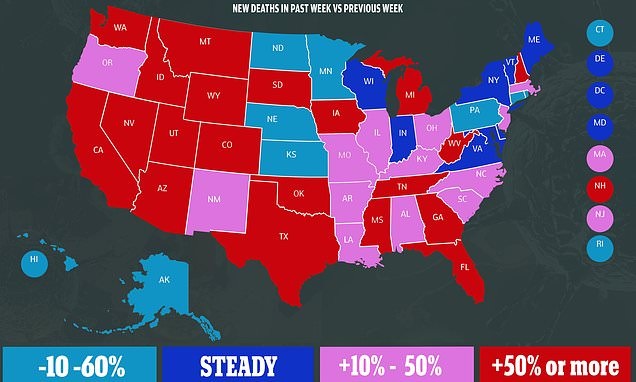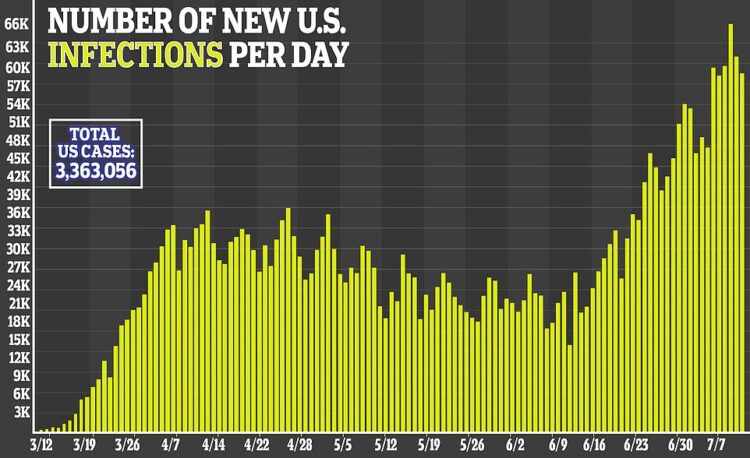Deaths related to COVID-19 have increased across the United States by 46 percent in the past week with Texas, Arizona and Mississippi reporting the biggest weekly spikes.
More than 5,000 people died from COVID-19 between July 6 and July 12, which is an increase of 46 percent compared to the previous week, according to a Reuters analysis of data from The COVID Tracking Project.
About a dozen states have reported increases in deaths for at least two straight weeks, including California, Florida and Texas.
New cases also continue to rise with the US reporting over 400,000 infections for the week ending July 12, which was up 21 percent from the previous seven days.
Nationally, new COVID-19 cases have risen every week for six straight weeks.
Forty-six states reported more new cases of COVID-19 last week compared to the previous week, the analysis found.
Cases are only falling on a weekly basis in New York, Tennessee, New Jersey and Delaware.
While Southern and Western states are seeing the biggest increase in cases, infections are also rising in the Midwest with Minnesota cases up 60 percent, Missouri up 40 percent and Iowa up 30 percent.
Currently, more than 135,000 Americans have died from coronavirus and there have been more than 3.3 million infections.
Until now, the number of deaths per day from COVID-19 had been falling for months even as hot spots states like Florida, Texas and Arizona saw explosions in cases and hospitalizations.
Daily infections across the US have broken records several times in recent days.
Health officials have been warning for weeks that deaths would surge again because the fatality rate lags several weeks behind infections.
A coronavirus death, when it occurs, typically comes several weeks after a person is first infected.
Experts had predicted states that saw spikes in cases and hospitalizations would, at some point, see deaths rise too.
The impact of the new surge in deaths has been felt by the healthcare workers grappling in overstretched hospitals with Texas and Arizona requesting refrigerated trucks as morgues reach capacity.
In Arizona, capacity within intensive care units had surged to 90 percent. Hospitalizations in Texas continue to spike to record highs with more than 10,000 people being treated on Monday.
Researchers expect deaths to rise for at least several weeks but some think the count probably will not go up as dramatically as it did in the spring.
A forecast model from the University of Washington’s Institute for Health Metrics is predicting the death toll to rise to 208,255 by November 1.
Experts say the death toll may not be as bad as when the pandemic first hit because testing was extremely limited early on and that many people’s health behaviors have now changed with mask-wearing becoming more common in some places.
Testing for COVID-19 rose by 7.4 percent in the United States last week and set a new record high on July 10, with over 823,000 tests performed, according to the Reuters analysis.
Nationally, 8.8 percent of tests came back positive for coronavirus, up from 7.5 percent the prior week and 5 percent three weeks ago.
The World Health Organization considers a positivity rate above 5 percent to be a cause for concern because it suggests there are more cases in the community that have not yet been uncovered.
Thirty-one states had positivity test rates above 5 percent, according to the analysis, including Arizona at 27 percent, South Carolina at 19 percent and Florida at 19 percent.
The surge in new cases has prompted many states to temporarily halt the reopening of their economies or order some businesses to close for a second time.
California’s Gov Gavin Newsom has once again closed bars, inside dining and, for much of the state, gyms, indoor church services and hair and nail salons in an effort to prevent COVID-19 cases from swamping hospitals.
The Gov issued the sweeping set of closures on Monday as the state recorded more than 329,000 cases and deaths topped 7,000. Hospitalizations have surged by 28 percent in the past two weeks, including a 20 percent increase in patients requiring intensive care.
‘COVID-19 is not going away anytime soon, until there is a vaccine and or an effective therapy,’ Newsom said.
The affected counties include Los Angeles and virtually all of Southern California.
In Los Angeles, Mayor Eric Garcetti immediately implemented the shutdowns and warned that the city was ‘on the verge’ of raising its COVID-19 threat level from orange to red — the highest level — and resorting to shutting down all but essential businesses.
Garcetti noted that Los Angeles County now has more virus cases than Canada.
‘We have never had as many people infected, or infectious,’ he said. ‘We’ve never had as many people in the hospital as there are tonight.’

